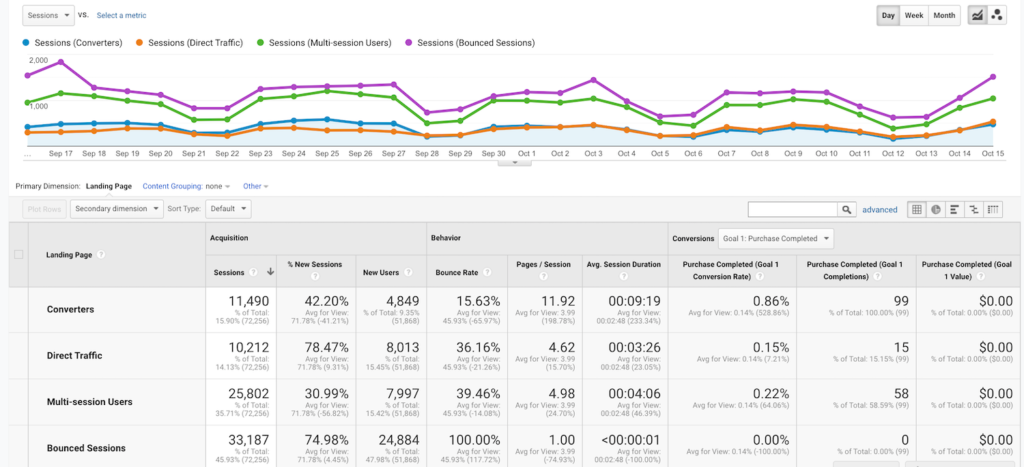Revealing the Blind Destinations: Recognizing What Google Analytics Goals Can not Measure
In the world of digital analytics, Google Analytics stands as an effective tool for tracking and assessing on the internet individual communications. Nonetheless, amid its durable capacities, there exist dead spots that typically avert dimension. Recognizing what Google Analytics objectives can not determine is critical for gaining an extensive view of user actions and engagement. As we dig into the ins and outs of these blind areas, we uncover a complex internet of undiscovered areas that hold useful insights into customer activities and motivations, difficult traditional wisdom and shedding light on the constraints of our data-driven understanding.
Individual Habits on External Platforms
Understanding just how customers engage on external systems is vital for enhancing on-line strategies. Exterior platforms, such as social media sites networks, recommendation websites, and on-line forums, play a significant duty in driving traffic to a firm's site. By analyzing individual behavior on these systems, companies can obtain important understandings into the efficiency of their advertising initiatives and the preferences of their target market.
One key element of customer behavior on exterior platforms is the referral source. By tracking where the customers are coming from, companies can identify which systems are driving the most traffic to their web site. This details can assist companies designate their sources better, concentrating on the systems that yield the finest outcomes.

Offline Conversions and Interactions
Examining individual behavior on exterior systems supplies important understandings into on-line approaches; nevertheless, thinking about offline conversions and interactions is equally vital for an extensive understanding of a firm's general performance. Offline conversions, such as in-store acquisitions or phone inquiries, play a considerable role in several services' success.

Acknowledgment Beyond Last Click
When diving right into the realm of electronic advertising and marketing analytics, it becomes vital to look beyond the solitary touchpoint of the last click for an extra comprehensive understanding of attribution. While Google Analytics supplies useful understandings right into user behavior, relying exclusively on last-click acknowledgment can be limiting - what data is google analytics goals unable to track. Acknowledgment versions that exceed the last click provide a much more nuanced sight of the consumer trip, taking into consideration all the touchpoints that lead to a conversion
Attribution beyond the last click allows marketers to appoint credit scores to different communications along the conversion path, giving a clearer image of the performance of various advertising and marketing networks. By discovering multi-touch acknowledgment designs such as linear, time degeneration, or position-based attribution, businesses can better designate their advertising budget plans and optimize their strategies for optimal influence.
Understanding the impact of each touchpoint in the conversion process is important for making informed choices and making best use of ROI. By welcoming attribution beyond the last click, organizations can obtain deeper understandings right into customer actions and customize their advertising efforts better.
Cross-Device and Cross-Browser Tracking

Similarly, cross-browser tracking complements cross-device monitoring by recording customer behavior as they change in between different web internet browsers. Understanding exactly how users interact with websites on numerous browsers can help marketers enhance their on-line experiences to ensure consistency and functionality across various platforms.
Qualitative Information and Individual Intent
Comprehending customer intent via qualitative data analysis is critical for developing targeted electronic marketing approaches that resonate with the requirements and preferences of the target market. Qualitative data supplies understandings into the 'why' behind individual actions, dropping light on inspirations, feelings, and choices that measurable information alone can not catch. By assessing individual comments, comments, and communications, online marketers can uncover valuable information concerning customer intent, enabling them to tailor their messaging, content, and offerings to better line up with what their audience is looking for.
Qualitative information also helps in recognizing the context in which customers engage with a site or application. This contextual understanding makes it possible for marketers to create even more pertinent and tailored experiences, eventually driving higher involvement and conversion rates. By delving right into user intent via qualitative information evaluation, companies can obtain a deeper understanding of find here their target market, causing more reliable advertising and marketing strategies that fulfill individuals' needs and assumptions.
Conclusion
Finally, Google Analytics objectives have restrictions in measuring individual behavior on outside systems, offline conversions, attribution past last click, cross-browser and cross-device you can check here tracking, and qualitative information associated to customer intent. what data is google analytics goals unable to track. It is very important for businesses to be knowledgeable about these blind places in order to supplement their data evaluation with various other tools and approaches to gain a much more thorough understanding of their audience and enhance their total digital advertising approaches
By analyzing individual behavior on these systems, services can obtain useful understandings right into the effectiveness of their advertising and marketing initiatives and the preferences of their target audience.
Evaluating customer habits on exterior platforms offers useful understandings right into on-line strategies; nevertheless, taking into consideration offline conversions and Homepage interactions is similarly vital for a thorough understanding of a firm's overall performance.In digital advertising analytics, moving beyond last-click acknowledgment to check out cross-device and cross-browser monitoring is crucial for gaining a holistic understanding of user interactions across various platforms and devices. By evaluating individual comments, comments, and interactions, marketing experts can reveal beneficial details concerning individual intent, enabling them to tailor their messaging, material, and offerings to better align with what their audience is seeking.
By delving right into customer intent with qualitative information analysis, services can get a deeper understanding of their target audience, leading to extra effective marketing techniques that fulfill users' assumptions and requirements.